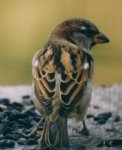March 2001
This is the time of year when garden birds begin to appreciate the food we
put out for them. Wild food stocks are dwindling with the new season’s crop
not due for some time. Seed eaters have been lucky  that the unharvested flax
has provided a good food source and my attention was drawn recently to a large
flock of a about 200 birds, mainly Goldfinches, making good use of this. It
was only last year that it was noted that Long Tailed Tits had started coming
to nut feeders and several people have reported seeing them this year.
that the unharvested flax
has provided a good food source and my attention was drawn recently to a large
flock of a about 200 birds, mainly Goldfinches, making good use of this. It
was only last year that it was noted that Long Tailed Tits had started coming
to nut feeders and several people have reported seeing them this year.
As the Redwing gather in chattering flocks preparing to return to northern climes, the first of the summer migrants has arrived. The repetitive call of the Chiff Chaff was heard on the 9th. Later this month the strident notes of the song of the Blackcap should be heard. Small numbers of both these birds have over wintered here in recent years with the outset of milder winters.
Given a frost free spell with some sunshine, early butterflies such as
Brimstone and Small Tortoiseshell should appear. However the numbers of
butterflies of almost all species have declined lately such that previously
‘common’ species seem almost rare.
should appear. However the numbers of
butterflies of almost all species have declined lately such that previously
‘common’ species seem almost rare.
It is unfortunate that, because of the current closure of all Footpaths and Bridleways, we are unable to access the countryside. However it is a small price to pay in order to help prevent the spread of this virulent disease which has such a dramatic and devastating effect on all it touches.
HIRUNDINE 11/03/2001




